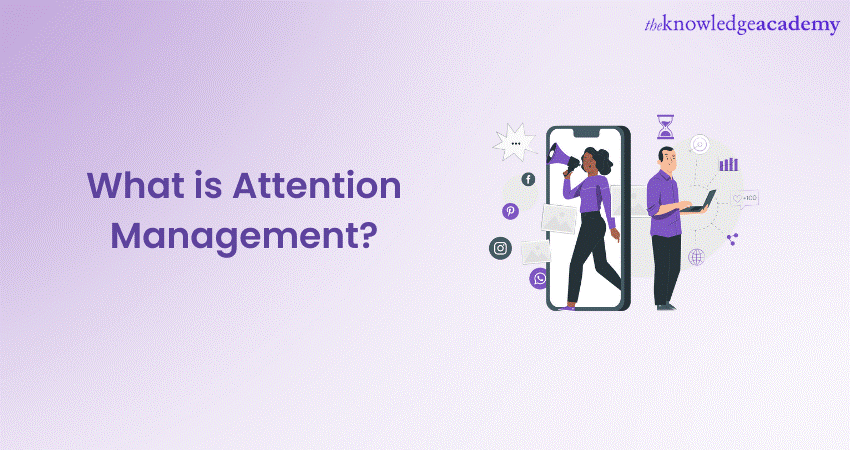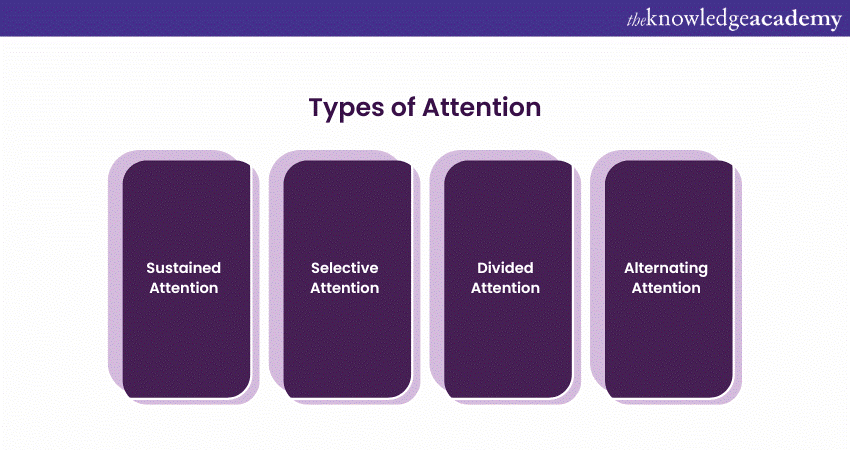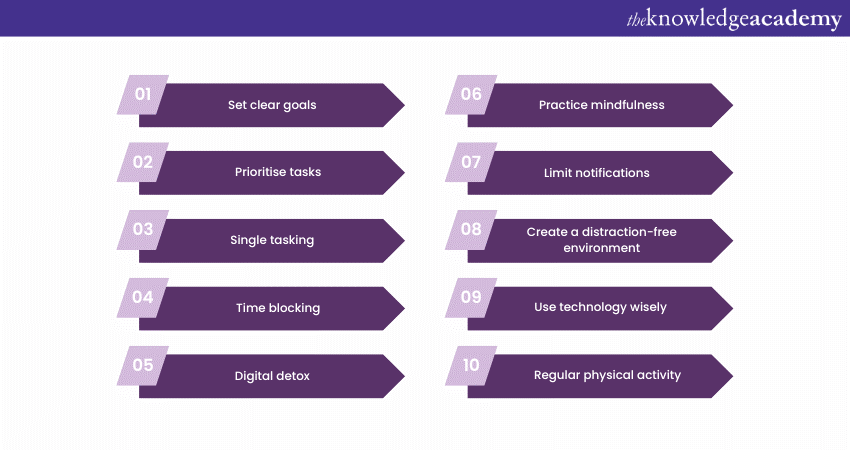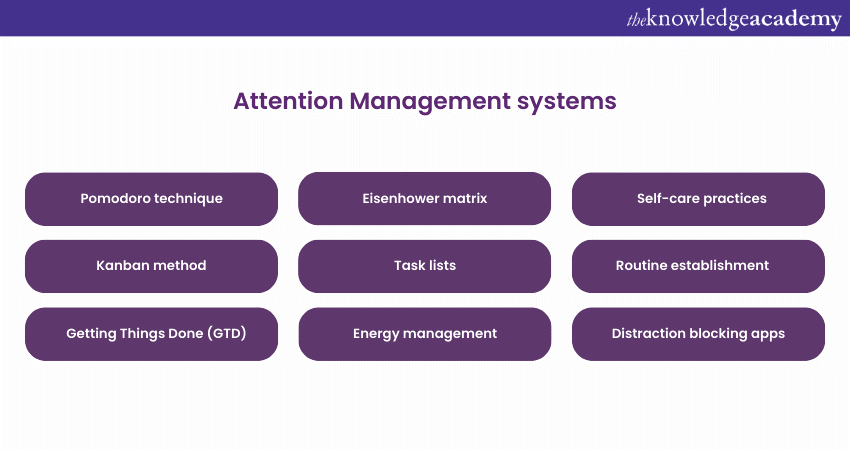We may not have the course you’re looking for. If you enquire or give us a call on +1800812339 and speak to our training experts, we may still be able to help with your training requirements.
Training Outcomes Within Your Budget!
We ensure quality, budget-alignment, and timely delivery by our expert instructors.

Have you ever found yourself struggling to focus on tasks in a world full of constant distractions? With information coming at us from all directions, understanding What is Attention Management has become more crucial than ever. It's not only about getting things done without distractions but also optimising your focus for a more productive and fulfilling life.
By learning various techniques, you can stay productive, focused and feel good mentally. Want to know how? In this blog, you will explore What is Attention Management, its significance in our daily lives, and practical strategies to make it work for you.
Table of Contents
1) Understanding What is Attention Management
2) Types of attention
3) Importance of Attention Management
4) How to improve Attention Management?
5) Challenges the in digital world
6) What are Attention Management systems?
7) Conclusion
Understanding What is Attention Management
Attention Management in simple terms is the practice of directing your focus and concentration on specific tasks or objectives while minimising distractions. It involves the following:
a) Organising your time
b) Prioritising tasks, and
c) Staying mindful of what needs your attention most
Following the above-mentioned practices ensure that you can work efficiently and effectively. Effective Attention Management also includes recognising and managing your own internal distractions, such as wandering thoughts or procrastination tendencies.
Learn how to improve your focus and manage your time – Join our Attention Management Training!
Types of Attention
After learning What is Attention Management, it’s time to learn about it’s various types. Attention comes in various forms, like different tools in a toolbox, each suited for specific tasks. These various forms are discussed below:

Sustained Attention
Sustained Attention is the ability to keep your focus on a single task or activity for an extended period. It's like shining a powerful spotlight on one thing, allowing you to go deep into it without being easily distracted. Think about reading a book. Sustained Attention is what lets you immerse yourself in it and make progress. This type of Attention is vital for tasks that require thorough thinking and concentration.
When you can maintain Sustained Attention, you're able to complete tasks more efficiently and produce higher-quality work. However, it can be challenging in a world full of digital distractions and constant notifications. Practising sustained Attention involves creating an environment that minimises interruptions. You also need to set aside dedicated time blocks for focused work.
Selective Attention
Selective Attention is like having a mental filter that allows you to concentrate on one thing while ignoring everything else. For example, you are in a busy party where many conversations are happening around you, yet you can focus on just one person's voice. This ability is crucial for staying on track and avoiding sensory overload. It enables you to prioritise what deserves your mental energy and ignore irrelevant ones.
In a world full of information, Selective Attention allows you to choose where to direct your focus. This skill is particularly valuable when you need to complete tasks that demand your undivided attention. By practising Selective Attention, you can increase your efficiency, reduce stress, and make better decisions. It is important to be aware of how you allocate your Selective Attention.
Divided Attention
Divided Attention involves attempting to handle multiple tasks or stimuli simultaneously. It's similar to juggling several balls at once, requiring you to allocate a portion of your cognitive resources to each task. While it might seem like a superpower, it's essential to recognise its limitations. Dividing your attention too thinly can result in reduced performance for all tasks involved.
In some situations, Divided Attention can be useful, such as when driving while listening to music. However, tasks that require significant effort, like problem-solving or learning, usually suffer from Divided Attention. Engaging in multiple tasks at once often leads to mistakes, slower completion times, and increased mental fatigue. To effectively manage divided attention, consider the complexity of tasks and prioritise those that truly require multiple focus.
Alternating Attention
Alternating Attention is the ability to shift your focus quickly between different tasks or activities. It's like smoothly switching gears in your mind, allowing you to adapt to changing demands. For instance, you might be playing a video game and then instantly shift your attention to respond to a question from your parent. This skill is essential when tasks require frequent context switching or when you need to balance different responsibilities.
While Alternating Attention can enhance flexibility, it's important to manage it wisely. Constantly shifting your focus can disrupt your workflow and decrease overall efficiency. Finding a balance between sustained focus and effective switching is key. With Alternating Attention, you become better equipped to handle multitasking.
Improve relationships and communication – Join today for the Active Listening Skills course!
Importance of Attention Management
The ability to manage your attention effectively is a skill that can profoundly impact your personal and professional life. Here are some key reasons why Attention Management is of paramount importance:
Productivity boost
Attention Management allows you to direct your focus towards tasks that truly matter. By minimising distractions and concentrating on high-priority activities, you can accomplish more in less time. This increased productivity can lead to a greater sense of satisfaction in your work.
Improved focus
With the constant flow of emails, messages, and notifications, maintaining focus has become a significant challenge. Attention Management system help you build the mental resilience to resist distractions and stay concentrated on your goals. This improved focus leads to higher-quality work and better outcomes.
Reduced stress
Information overload and constant multitasking can lead to stress and burnout. By managing your attention, you can create a more controlled and calmer work environment. This, in turn, reduces the cognitive load and emotional strain caused by trying to juggle multiple tasks at once.
Better decision-making
When you're able to focus your attention on a single task, your cognitive abilities are optimised. This leads to improved critical thinking, problem-solving, and decision-making. Clarity of thought allows you to make well-informed choices rather than succumbing to impulsive decisions.
Enhanced creativity
Attention Management systems often incorporate techniques that encourage taking breaks and allowing your mind to wander. These moments of rest are crucial for sparking creativity and innovation. By giving your brain the opportunity to disconnect, you create space for novel ideas to emerge.
Effective learning
Whether you're studying, attending a workshop, or learning a new skill, Attention Management is vital for grasping and retaining information. By dedicating focused periods of time to learning and minimising distractions, you can grasp concepts more deeply and make the most of your educational experiences.
Work-life balance
In a world where work often spills over into personal time, Attention Management can help you set clear boundaries. By allocating specific time blocks for work and leisure, you can maintain a healthier work-life balance, leading to increased overall well-being.
Long-term goal achievement
Attention Management involves setting clear goals and intentions. By consistently focusing on your long-term objectives, you increase the chances of achieving them. It ensures that you allocate time and energy to tasks aligned with your desired aspirations.

How to improve Attention Management?
In today’s world, having Attention is important to improve the overall productivity of an individual. Here, we have discussed a few ways through which you can improve your Attention Management skills:

Set clear goals
Before diving into tasks, define what you want to achieve. Clear goals act like a compass, guiding your attention towards what truly matters. By knowing your objectives upfront, you avoid aimless wandering and channel your energy into meaningful tasks that align with your purpose.
Prioritise tasks
Adopt techniques like the Eisenhower Matrix to sort tasks into urgent, important, non-urgent, and non-important categories. This systematic approach clarifies what needs immediate attention versus tasks that can wait. Prioritisation sharpens your focus on high-impact tasks, preventing you from getting bogged down by less significant activities.
Single tasking
Focus on one task at a time instead of juggling many. This deepens your concentration, allowing for quality output. Single-tasking minimises the mental load associated with frequent task-switching, enhancing efficiency and reducing the likelihood of errors.
Time blocking
Assign specific time slots for different tasks. During these blocks, eliminate distractions and immerse yourself fully in the task. This method optimises your attention's effectiveness by dedicating uninterrupted periods to focused work, boosting productivity and task completion.
Digital detox
Plan regular intervals to disconnect from digital devices. These breaks rejuvenate your mind, reducing digital clutter and the compulsion to check notifications. Detaching from screens enhances your ability to refocus and engage in tasks without constant interruptions.
Practice mindfulness
Incorporate mindfulness techniques like meditation into your routine. These practices enhance self-awareness of your attention's ebb and flow. When your focus wavers, mindfulness helps you gently steer it back, fostering better control over your attention and concentration.
Limit notifications
Trim non-essential notifications on your devices. By doing so, you prevent disruptive interruptions that fracture your attention. Regaining authority over your notifications empowers you to engage with your tasks proactively and without unnecessary distractions.
Create a distraction-free environment
Craft a workspace that minimises physical clutter and disruptions. An organised environment supports focused work by reducing visual and auditory distractions. By curating your surroundings, you provide your Attention with a conducive space to thrive.
Use technology wisely
Harness productivity tools and apps that align with your Attention Management goals. These tools can block distracting websites, track time usage, and send reminders for breaks. Strategic technology use bolsters your efforts in maintaining focus and staying on track with your tasks.
Regular physical activity
Physical activity positively impacts your cognitive function. Regular exercise enhances your ability to focus, improves mood, and reduces stress. Incorporating movement into your routine can significantly contribute to your Attention Management effort
Challenges in the digital world
The digital age has revolutionised how we live and work. It offers unparalleled convenience and access to information. However, it has also introduced a set of challenges that can significantly impact our ability to manage attention effectively. Discussed below are some of the key challenges we face in the digital era:
FOMO (Fear of Missing Out)
The Fear of Missing Out or FOMO on the latest news, events, or social interactions can drive compulsive checking of notifications and updates. FOMO creates a sense of urgency that can fragment our attention as we try to stay connected to multiple sources of information simultaneously.
Technological dependence
Our dependence on digital devices and technology has narrowed down the boundaries between work and personal life. The constant availability of communication and information can make it challenging to disengage and allocate focused attention to other aspects of life, such as relaxation and relationships.
Reduced face-to-face interaction
The prevalence of digital communication can lead to a decline in face-to-face interactions. While digital communication offers convenience, it lacks the nuanced cues and emotional depth of in-person conversations. This shift can impact our ability to effectively manage attention during real-time interactions, affecting our understanding and connection with others.
Multitasking myth
In the digital age, multitasking has become almost synonymous with productivity. However, research consistently shows that multitasking is a myth – our brains are not designed to focus on multiple complex tasks simultaneously. Attempting to juggle various tasks can result in reduced quality of work, increased errors, and heightened stress levels.
Shortened Attention spans
The rapid pace of digital content consumption, characterised by short videos, bite-sized articles, and quick updates, has contributed to shortened attention spans. Constant exposure to easily digestible content can diminish our ability to engage deeply with more complex or lengthy materials, making tasks that demand sustained Attention a challenge.
Information overload
The digital world provides us with a wealth of information at our fingertips. While this can be empowering, it also presents a challenge: the sheer volume of information can lead to cognitive overload. Processing and filtering through the abundance of data can exhaust our mental resources, leaving us fatigued and struggling to sustain attention on any one task.
Supercharge your personal growth journey today - Join Motivation and Goal Setting Training now!
What are Attention Management systems?
Attention Management systems are tools, techniques, and frameworks designed to aid individuals in effectively managing their attention. These systems provide structured approaches to minimise distractions, improve focus, and enhance overall productivity. We will discuss about various types of Attention Management systems below:

Pomodoro technique
This technique involves working for around 25 minutes (a "Pomodoro") followed by a 5-minute break. After completing four Pomodoros, you take a longer break. This approach prevents burnout, maintains focus, and improves time management by breaking work into manageable intervals.
Kanban method
Using a visual board with columns like "To-do," "In progress," and "Done," you can see the status of tasks briefly. This helps prioritise tasks, manage workflow, and prevent overwhelming multitasking by limiting work in progress.
Getting Things Done (GTD)
GTD encourages capturing all tasks and ideas in an external system, eliminating mental clutter. Tasks are organised into actionable steps, projects, and categories, facilitating focus on current tasks while maintaining a clear overview of your responsibilities.
Eisenhower matrix
Tasks are classified into four quadrants based on urgency and importance. This system guides decision-making, prompting you to address high-priority tasks immediately, delegate or schedule tasks, or eliminate tasks that contribute little value.
Task lists
Listing tasks help you prioritise and track work. Crossing off completed tasks provides a sense of accomplishment, while the structure of a list prevents tasks from slipping through the cracks and ensures nothing goes unnoticed.
Energy management
Recognising your energy peaks and valleys throughout the day allows you to allocate demanding tasks to high-energy periods. This synchronisation between task complexity and energy levels optimises attention and productivity.
Self-care practices
Maintaining physical health through exercise, getting adequate sleep, and adopting a balanced diet contributes to sustained attention. Mental well-being practices like meditation and relaxation techniques further support Attention Management.
Routine establishment
Consistent routines create predictability, helping your brain prepare for focused work. Engaging in tasks at the same times each day conditions your mind for better attention during these periods, enhancing productivity.
Distraction blocking apps
These apps restrict access to distracting websites and notifications, ensuring you stay focused during designated work periods. They serve as digital gatekeepers, enhancing attention by reducing the temptation of online distractions.
Conclusion
In the end, paying “attention” to Attention Management is very important. With different systems like time blocks, Pomodoro, and lists, you can focus better. Less stress, better work, and a balanced life are some benefits it offers. Remember, finding what works for you is the key.
Unlock your potential with our transformative Personal Development Course - Join today!
Frequently Asked Questions
Upcoming Business Skills Resources Batches & Dates
Date
 Attention Management Training
Attention Management Training
Fri 10th Jan 2025
Fri 28th Feb 2025
Fri 4th Apr 2025
Fri 16th May 2025
Fri 11th Jul 2025
Fri 19th Sep 2025
Fri 21st Nov 2025







 Top Rated Course
Top Rated Course


 If you wish to make any changes to your course, please
If you wish to make any changes to your course, please


